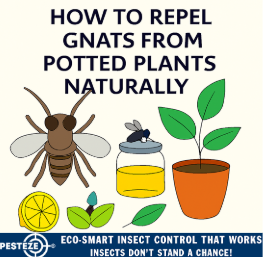HOW TO REPEL GNATS FROM POTTED PLANTS NATURALLY

HOW TO REPEL GNATS FROM POTTED PLANTS NATURALLY
SUMMARY
Gnats buzzing around potted plants are a common nuisance for indoor gardeners. These tiny pests often lay eggs in moist soil and can quickly multiply. Fortunately, with simple adjustments to watering habits, natural repellents, and safe barriers, you can protect your plants and keep your home gnat-free—without using harsh chemicals.
FEATURES
-
Adjust Watering Habits – Let soil dry between waterings to discourage gnat breeding.
-
Cover Soil with Sand or Pebbles – Creates a barrier that prevents gnats from laying eggs.
-
Use Natural Repellents – Essential oils like neem, peppermint, or eucalyptus repel gnats safely.
-
Introduce Beneficial Nematodes – Microscopic organisms that attack gnat larvae in soil.
-
Set Up DIY Traps – Apple cider vinegar and sticky traps help capture adult gnats.
-
Repot with Fresh Soil – Replace infested soil to eliminate gnat eggs and larvae completely.
GUIDE DESCRIPTION
Gnats are a common problem for potted plant owners. While they don’t harm humans, fungus gnats can damage plant roots in large numbers and make your home less pleasant. The key to solving this problem is tackling both adult gnats and their larvae in the soil.
The first step is adjusting your watering habits. Fungus gnats thrive in damp soil, so allowing the top layer to dry out between waterings makes the environment less attractive for egg-laying. Always check soil moisture before adding more water.
Creating a soil barrier is another effective method. Cover the surface with sand, gravel, or decorative pebbles to prevent adult gnats from accessing the soil. This simple step disrupts their breeding cycle while enhancing the look of your pots.
For added protection, consider natural repellents. Neem oil, peppermint oil, and eucalyptus oil can be diluted with water and applied as a spray to the soil surface. These oils deter adult gnats and help protect plant health.
Another eco-friendly option is introducing beneficial nematodes, microscopic organisms that feed on gnat larvae in the soil. Available in garden centers, they offer long-term, natural control.
While you address the soil, set up DIY traps for adult gnats. A small dish with apple cider vinegar and a drop of dish soap attracts and traps gnats. Yellow sticky traps placed near plant pots also catch flying adults, reducing their numbers.
If infestations persist, it may be necessary to repot with fresh soil. Remove your plant carefully, discard the old soil, and clean the pot before replanting. This eliminates eggs and larvae, giving your plant a fresh start.
By combining moisture control, barriers, repellents, and traps, you can effectively repel gnats from your potted plants and maintain a healthier indoor garden.
- Shashank Rongali


Comments 0